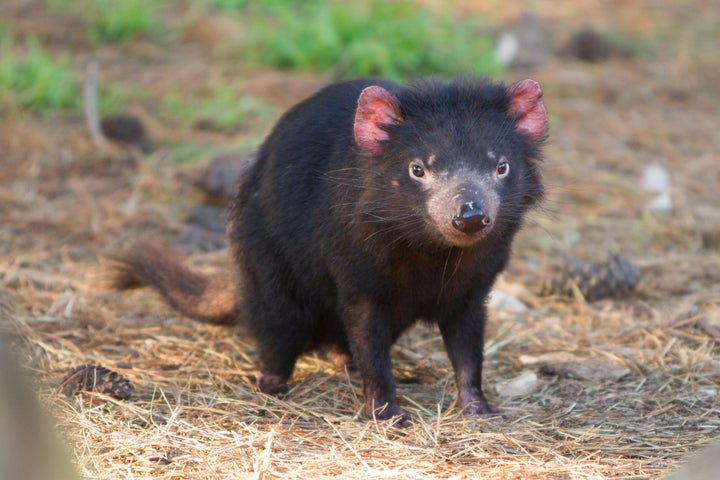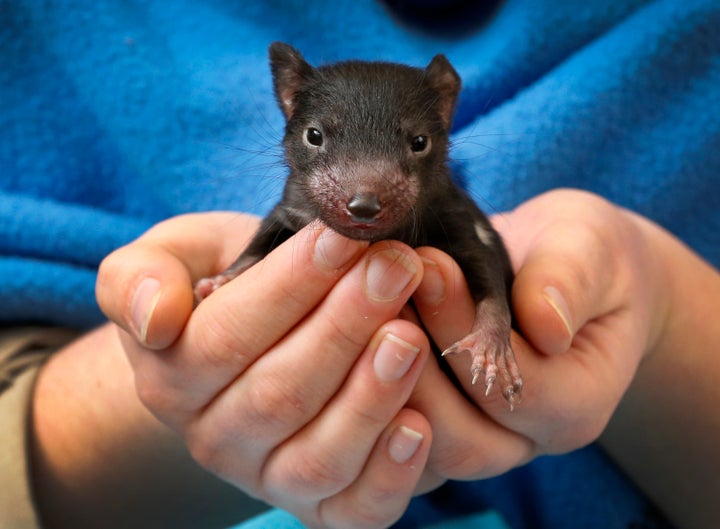
Tasmanian devils have proven themselves to be survivors.
An “evolutionary relic,” researchers have found evidence of devil life dating back 100,000 years; its ancestors have been around for millions. It’s the largest carnivorous marsupial left on the planet, having outlived others like the Tasmanian wolf and marsupial lion. And despite being driven to extinction on the mainland of Australia around four centuries ago, the tenacious creature managed to win the battle for its continued existence, successfully carving out a home for itself on the island state of Tasmania.
Then, 20 years ago, a new hazard emerged.
A highly contagious and incurable form of cancer called Devil Facial Tumor Disease (DFTD) began wiping out devil populations. Characterized by gruesome lesions and lumps that manifest on the marsupials’ faces, the condition killed nearly 100 percent of devils that contracted it.
In the years since, DFTD has infected almost all devil populations in the wild, prompting an overall population decline of over 80 percent.
“The Tasmanian devil cancer is the only cancer that is threatening an entire species with extinction,” researcher Elizabeth Murchison said in 2012.
Without a cure or other drastic intervention, experts warned that the animals would be wiped off the face of Earth in less than 30 years.
In typically devilish fashion, the creatures didn’t take this dire prediction lying down.

According to a study published this week in the journal Nature Communications, the endangered species seems to be rapidly evolving to resist the virulent cancer — and this stab at survival may be enough to keep them alive.
Researchers said they’d been prompted to embark on the study after realizing that some Tasmanian devils were outliving scientists’ predictions. Predictive models had foreseen extinction in some long-diseased local devil populations, but many of them had persisted.
Being extremely social creatures, it wasn’t likely that the devils in these communities had not been exposed to the disease. After all, part of the reason the cancer managed to spread so efficiently was because of the naturally aggressive disposition of the devils, who often bite each other’s faces while mating and fighting.
“As comical as it is, the familiar Looney Tunes portrayal of a Tasmanian devil as a seething, snarling, insatiable lunatic is, at times, not all that far from the truth,” National Geographic reported. “Tasmanian devils have a notoriously cantankerous disposition and will fly into a maniacal rage when threatened by a predator, fighting for a mate or defending a meal.”
Given these factors, researchers figured something else had to be at play, something that was keeping the devils alive.
“At that point, our hypothesis was maybe there was evolution,” Andrew Storfer, evolutionary geneticist at Washington State University and study co-author, told the Washington Post. “The challenge, of course, was finding evidence in the genome.”
Fortunately, Storfer and his team had a lot to work with. DNA samples have been gathered from Tasmanian devil populations for years, stretching back to the 1990s. By comparing the DNA samples of devils before and after the DFTD outbreak, the researchers were able to pinpoint any changes in the devil genome.
What they found greatly heartened them.
As the paper detailed, the researchers discovered changes in two regions of the genome associated with immune function and cancer response. Their findings suggested that devils were “evolving immune-modulated resistance that could aid in species persistence in the face of this devastating disease,” the study said.
More research is needed to figure out exactly how these genome variations are helping devils survive. They may, for instance, not provide complete resistance, but instead allow the devils to survive long enough to reproduce.
Still, Storfer said he now feels “optimistic” about the animals’ future.
“This gives us hope for the survival of the Tasmanian devil, which is predicted to be extinct but isn’t,” Storfer said, per the BBC. “We see that the devils apparently are evolving genes that may be associated with resistance to the disease.”
The brisk pace of these adaptations was also cause for excitement, Storfer added.
“We’re talking about roughly six generations in some populations, which is a very short period of evolutionary time,” he said.

Infectious cancers like DFTD are extremely rare in nature. Only two others are currently known: a sexually-transmitted tumor that spreads among dogs and another, discovered in 2015, that affects clams.
Storfer said further research into DFTD could offer answers to questions about the evolution of cancer transmissibility in general, “and what causes remission and reoccurrence in cancer and other diseases.”
